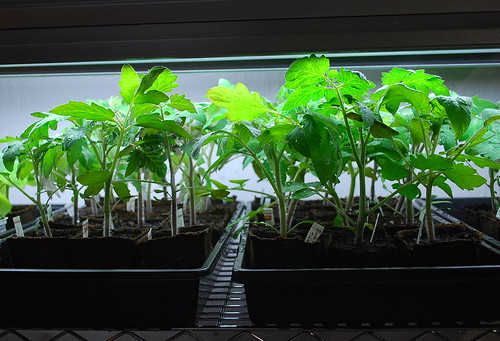
This will be my first full year of vegetable gardening. When I was putting together my garden calender a few months ago, my main objective was to stretch the summer growing season for as long as I could. That meant starting some seeds earlier than usual. I've had some successes (like my Tuscan kale, mizuna and bok choy) but the more I think about it, the more I am convinced that there is indeed such a thing as the "Art of Timing" when it comes to growing things. My tomatoes have definitely been a learning experience.
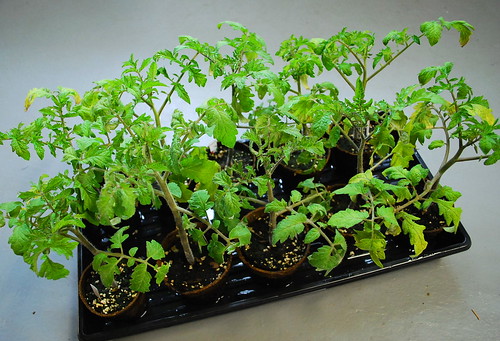
This year, I'm growing 20 different varieties of tomatoes, close to 50 plants total. I sowed my super early tomatoes (above) in late February. The idea was to transplant these undercover about 2 - 3 weeks before our average frost date (which will be this upcoming weekend) in hopes of getting a super early crop. They are about 10-12 inches tall and completely hardened off. Since I'd run out of indoor growing space weeks ago, they have been spending their days outside. As you can see, the outdoor elements have taken their toll on these plants. The leaves are yellowing and curling. It also didn't help that they were attacked by aphids at a young stage. These plants are definitely showing signs of stress.
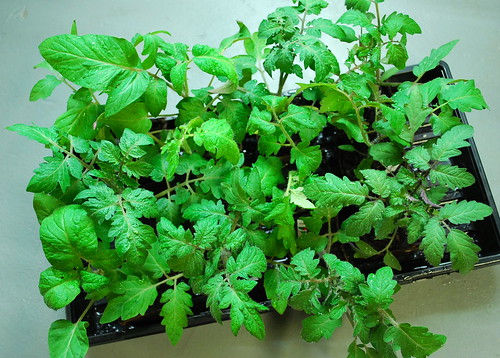
In contrast, the tomatoes I started in mid-March are looking lush and green. At the moment, they are only 6-8 inches tall but growing VERY quickly. They have had the luxury of spending all of their time under the protective environment and constant glow of my indoor lights. I have a feeling that once I transplant these guys in early May, they will outperform the other plants. So unless I can find adequate space indoors to care for my super-early tomatoes next year, I'm sticking to a mid-march sowing date.
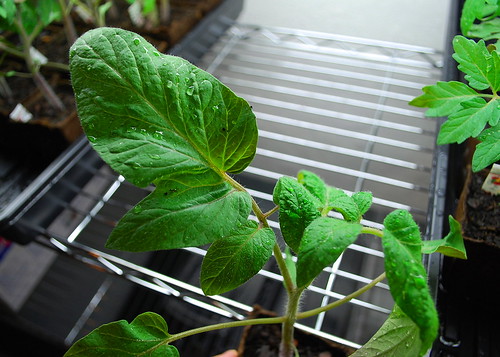
On a side note, I'm finding the leaves on the Brandywine to be particularly interesting. They are smoother and less-jagged than the other varieties I'm growing. Hopefully, they will grow well this year.
Final thought: I was planning on planting my tomatoes similarly to how Cynthia from Love Apple Farm plants hers. Upon reading her instructions, you get the sense that she throws everything but the kitchen sink inside her planting holes. I wondering how other gardeners planted their tomatoes and amended their planting holes. I'm aiming for a simpler yet proven technique. Any advice would be greatly appreciated!
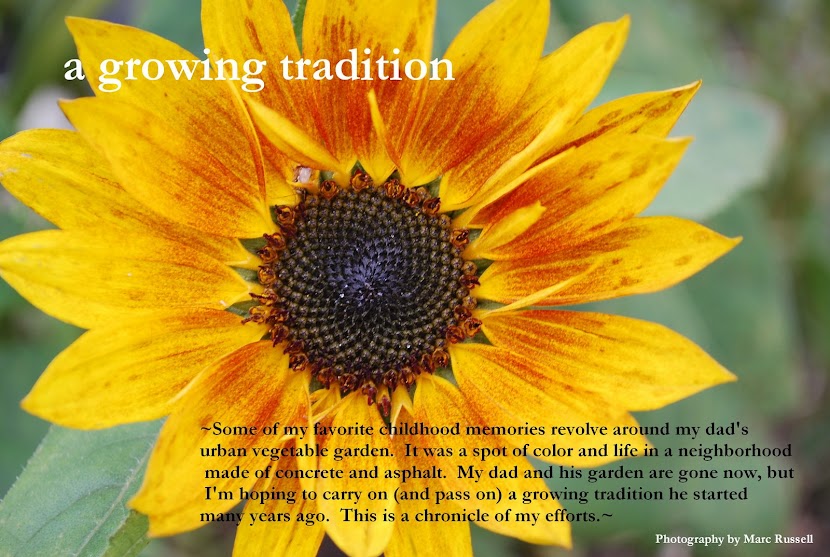





I hesitate to offer anyone advice since I'm only in my second year of vegetable gardening, but I have had good luck with tomatoes. One thing you might consider is that tomato leaves turning yellow can be a sign of magnesium deficiency. An easy remedy is to sprinkle epsom salts around the plant and water well.
ReplyDeleteIn my short experience I have found that seedlings started ahead of schedule will lose their head start within a few weeks - the seedlings begun at the recommended time seem to catch up pretty quickly. The hardest part is the patience required to wait for the proper time!
I wish you all the best with your seedlings!
I throw everything into the planting hole. I grind up eggshells in the blender (after I've set them out to dry) and toss in a few aspirin tablets, old calcium tablets (I buy the huge bottle from Costco, and never get them all taken before the expiration date), even some multi-vitamin/mineral caplets if I have them on hand. I just grind it all up together and scratch about 1/4 cup into the bottom of each planting hole. Does it help? Dunno....but it doesn't hurt ;-)
ReplyDeleteI've always found small, sturdy tomato plants catch up and pass the larger ones by. I start mine mid-March for May 1 planting. Six weeks for tomatoes, eight for peppers. I still don't have the timing right for brassicas.
Hi Thomas, we had visitors over the weekend, visiting from Alaska and when they saw all the tomato plants in the "greenhouse" they asked if I was supplying the neighborhood, to which I responded, "I had 100 % germination... what can I do? ;) I know someone will want a few of the plants.
ReplyDeleteAs for what I feed the tomatoes: when they were about 3” tall and with several true leaves, I transplanted to pots with a little Lime, added Fish Fertilizer (weak dosage) and now am adding kelp. I have transplanted them now into larger pots, removing all lower leaves and planting them deeper into the soil. I have blossoms on a few and now stop the fish fert and adding some wood ash, kelp and some epsom salt.
I know I started some too early, but excitement got the better of me. ;) Never too old to learn.
P.S. added some egg shells on top of the larger potted ones like Granny.
Reading that tomato planting article makes me want to start over with planting mine out! I too started a little early, and see a big difference between the 1st and 2nd round--although only 1 of 3 plants survived round 2 for some unknown reason, but the survivor is healthy as a horse. Too bad it's going into a container... Now I'm armed for next year! ;)
ReplyDeleteI can’t agree with you more on the "Art of Timing". I have learned this also on my tomato plants this year. They are too big, too tall, and just like yours; leaves are curling up and getting yellow. I am sure that once they are planted out, they will recover fully. I just hate to see them like this.
ReplyDeleteRegarding the planting hole - I don’t add anything. I added manure to soil in fall and this is it.
I will probably add some organic fertilizer month after planting them in the garden.
My two generations of tomatoes will continue since I love having a "backup plan"! I set mine out and we got down into the 30's one night - they look fine, but it sure was nice to know I had another set still in a flat about 4 weeks younger! I use a combination of potting soil, compost, and topsoil from our yard soil pile mixed with perlite to lighten it if I have it handy, so depending on what the mix looks and feels like, I add Tomato Tone dug in. This year, I only added crushed eggshells into the planting hole, occasionally foliar feed with seaweed spray or water with a fish emulsion. I'm not sure if any of this helps though! You will love the Brandywine - I am growing 7 different heirlooms, but I made sure I have at least 6 Brandywines, they are the staple of all my canned sauces, and my favorite is just a fresh one sliced with salt! The seeds save very well also, my 3 year old seed germinated at 100% this year!
ReplyDeleteI mix into a deep planting hole: 1c 5-3-3 organic fertilizer, 1c bonemeal, 1c powdered eggshells (which are better than whole or just crushed). Aspirin is a good idea too, though I haven't used that yet. I don't put in worm castings or fish. I space my tomatoes 2' apart along the back of my bed and put carrots in a one foot strip in the front of that and peppers in a one foot strip in the front of the bed. I plant ground control marigolds between tomatoes at the far back edge of the bed but alternate sections (ie for 8 tomatoes I'd have 4 marigolds). The marigolds keep the nematodes under control.
ReplyDeleteOk, I stopped reading Cynthia's technique when I saw the fish heads.
ReplyDelete"This will be my first full year of vegetable gardening." Wow, I'm even more impressed, now. This will be my first year of growing things other than dirt. I have a ways to go.
The Brandywine is a potato-leaf variety, the leaves look completely normal.
ReplyDeleteI like to use Cynthia's amendments for general bed preparation (crab meal, sulfate of potash, and humic acid). But I completely ignore her advice for stuffing the planting hole. Eggshells are a great source of calcium, but the plants need the calcium when the fruits are sizing up and when the plants get large enough for that the roots will be growing well beyond the planting hole where most of them won't have access to all that lovely calcium. I dig my crushed eggshells into the entire bed. Ditto for the the rest of the amendments - put them where the roots of the mature plants can get to them.
Fish heads, I prefer to put them into a hot compost pile!
Thomas, I totally share your experience of planting tomatoes too soon indoors and then regretting it. I planted mine last week as I won't be planting out until June 1 or later here in Maine. I have to laugh at myself because I have a bunch of mini cubes that didn't germinate right off and then they all fell over and I don't know which is which. If I ever get any plants I do plan to go with the love apple farm directions this year. I have been growing tomatoes for over 30 years.
ReplyDeleteYour tom's look good! In general I don't think starting tomatoes early gives an early crop either. If you start a couple early producing varieties in February I think it is worth the effort though.
ReplyDeleteCall me lazy but I don't put anything in my tomato holes. I just turn the bed, amend overall with compost and organic fertilizer and just plant them.
Oh and your Brandywine is a potato leaf variety, all brandywine's have them. PL varieties are older and less developed then your regular leaf tomato plants. The PL varieties will cross so if you save seed then need to be separated.
I think they'll be just fine, Thomas. The potato leaf varieties are definitely something to marvel, and I find them interesting as well.
ReplyDeleteThanks for all of the great info guys. Eggshells seem to be all the rage. Haha. I wish I had saved mine over the winter but alas, I got lazy. I might have to go the calcium tablet route.
ReplyDeleteBelieve it or not, I do have a couple of fish heads and a bunch of shrimp shells. Hopefully a few of the tomatoes like them.
Yes, definitely, timing is an art and a very important one. If this is your first full year of gardening, it is too soon for you to reach conclusions. You might gain good information if you give some plants of the earlier batch a chance and observe them throughout the season. Some times plants that are stressed as seedlings turn out to be hardier in the real word of the garden. Sometimes they fail. Over the years I've seen both happen.
ReplyDeleteIf your goal is to extend the season, could you use your beautiful hoop-houses to plant the earlier batch sooner in the ground under cover?
Amending the soil depends on what kind of soil you have. For instance, Cynthia's amendments provide some minerals that I have in excess in my soil. Her experience is useful as an indication of what a tomato needs. But how you will provide it depends on the specifics of your site. Best to find a locally proven technique.
Since my soil is very different from yours take this with a grain of salt: I am also one of those who don't add anything special to the planting whole. I try to have a balanced soil with lots of organic matter in the whole bed and then leave it to the plants to figure out how to get what they need.
Sorry for the super long comment, your post has a lot of food for thought.
The Art of Timing: life summed up :-)
ReplyDeleteThe best way to support your tomato plants is with The Tomato Stake.
ReplyDeleteEasier to use than metal cages or upside down planters, stronger than bamboo and won't rot like wood stakes. The built-in twist-tie supports make tying your tomato plants easy!